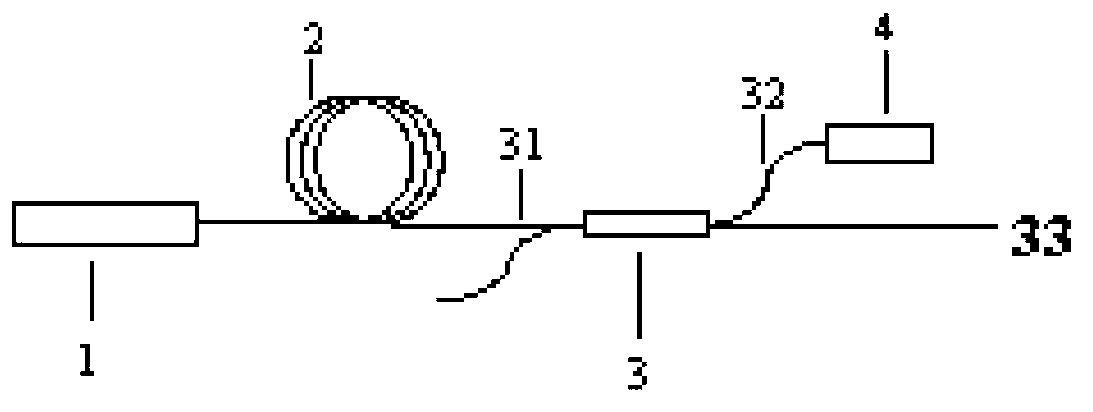Single-frequency Raman optical fiber laser device system
A technology of fiber laser and Raman fiber, which is applied in the direction of lasers, laser components, phonon exciters, etc., can solve the problems of system complexity and reduce system stability, so as to simplify the system, improve energy utilization efficiency, and improve The effect of stability
- Summary
- Abstract
- Description
- Claims
- Application Information
AI Technical Summary
Problems solved by technology
Method used
Image
Examples
Embodiment 1
[0028] Example 1 The system outputs 1178nm single-frequency linearly polarized laser:
[0029] Single longitudinal mode Raman fiber laser 1 uses the same quartz-matrix polarization-maintaining Raman gain fiber as Raman amplifying gain fiber 2, which is a distributed feedback Raman fiber laser with π phase shift. The rest of the pumping light from the pumping light source 4 obtains 1178nm single-frequency linearly polarized laser light. The peak value of the Raman gain spectrum of the quartz-matrix polarization-maintaining Raman gain fiber corresponds to about 13.4THz, and the calculated wavelength of the pump light is 1120nm. Therefore, the pump light source 4 selects a linearly polarized ytterbium-doped fiber laser with a center wavelength of 1120nm. The multiplexer 3 is a polarization-maintaining wavelength division multiplexer with a wavelength of 1120nm / 1178nm. The Raman amplification gain fiber 2 suppresses the stimulated Brillouin scattering accompanying the 1178nm lase...
Embodiment 2
[0030] Embodiment 2. System design output 1270nm single-frequency linearly polarized laser:
[0031] Single longitudinal mode Raman fiber laser 1 uses the same quartz matrix polarization-maintaining Raman gain fiber as Raman amplifying gain fiber 2, which is a distributed Bragg reflector Raman fiber laser. The pump light of Puyuan 4 obtains 1270nm single-frequency linearly polarized laser light. The peak value of the Raman gain spectrum of the quartz-matrix polarization-maintaining Raman gain fiber corresponds to about 13.4THz, and the calculated wavelength of the pump light is 1120nm. The pump source 4 is a non-polarization-maintaining all-fiber Raman fiber laser with a center wavelength of 1200nm. The wavelength division multiplexer 3 selects a polarization-maintaining wavelength division multiplexer with a wavelength of 1200nm / 1270nm. The 1200nm pump light provided by the pump source 4 amplifies the 1270nm single-frequency laser light generated by the single longitudinal m...
Embodiment 3
[0032] Embodiment 3 The system outputs a 2.35 μm single-frequency laser with no requirement on the polarization state:
[0033] Single longitudinal mode Raman fiber laser 1 uses the same tellurite matrix non-polarization-maintaining Raman gain fiber as Raman amplifying gain fiber 2, which is a Raman fiber laser with distributed Bragg reflectors. The pump light from the pump light source 4 obtains 2.35 μm single-frequency laser light. The Raman gain spectrum peak of tellurate matrix non-PM Raman gain fiber corresponds to about 750cm -1 Wavenumber, the pump light wavelength is calculated to be 2 μm, so the pump light source 4 uses a non-polarization-maintaining thulium-doped fiber laser with a center wavelength of 2 μm, and the wavelength division multiplexer 3 uses a non-polarization-maintaining WDM laser with a wavelength of 2 μm / 2.35 μm multiplexer. The Raman amplification gain fiber 2 suppresses the stimulated Brillouin scattering accompanying the 2.35 μm laser amplificati...
PUM
 Login to view more
Login to view more Abstract
Description
Claims
Application Information
 Login to view more
Login to view more - R&D Engineer
- R&D Manager
- IP Professional
- Industry Leading Data Capabilities
- Powerful AI technology
- Patent DNA Extraction
Browse by: Latest US Patents, China's latest patents, Technical Efficacy Thesaurus, Application Domain, Technology Topic.
© 2024 PatSnap. All rights reserved.Legal|Privacy policy|Modern Slavery Act Transparency Statement|Sitemap


